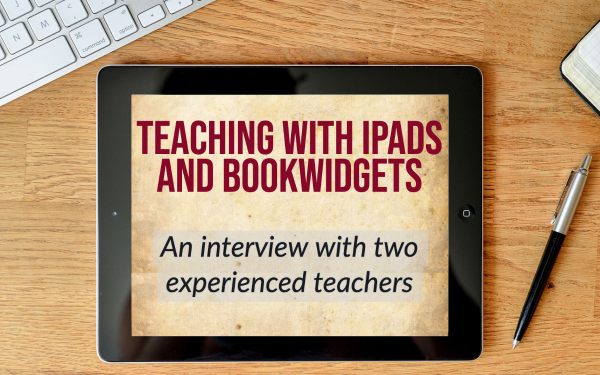Teaching with iPads and BookWidgets - What can we learn from a school that has 10 years of experience?
 Dimitri Bongers —
Dimitri Bongers —
Since March 2020, terms such as lockdown, social distancing, self-isolation, clusters … have become part of our commonly used vocabulary. Simultaneously, with schools being closed, terms such as digital learning, flipping the classroom, breakout rooms and BookWidgets have entered the teachers’ commonly used vocabulary. Whereas we all hope the pandemic-related vocabulary will soon be part of the past, it’s pretty clear that most teachers will continue to use some of the principles and tools they discovered while teaching remotely.
In many countries, governments and schools are investing heavily in hard- and software, so that the benefits from online teaching can also be applied in a non-pandemic context. Still, many teachers are struggling with the transition from their traditional way of teaching towards a new, hybrid method with devices such as iPads and Chromebooks as well as a wide range of online tools available. That’s why I interviewed two teachers of a Belgian school where iPads were introduced already 10 years ago.
 Sofie Van
Damme
is a Dutch and History teacher at Sint-Jozef Sint-Pieter
school, a Belgian secondary school with about 700
students and 80 teachers where she has been working for over 20 years. She
also works for a publishing company, where she contributes to a dutch handbook,
used in secondary schools in Flanders.
Sofie Van
Damme
is a Dutch and History teacher at Sint-Jozef Sint-Pieter
school, a Belgian secondary school with about 700
students and 80 teachers where she has been working for over 20 years. She
also works for a publishing company, where she contributes to a dutch handbook,
used in secondary schools in Flanders.
 Björn
Carreyn is a
Mathematics, Economics, and IT teacher at the same school since 2001. He has
been contributing to handbooks for science and maths and is an Apple
Distinguished educator since 2013. Besides that, he also gives trainings about the
use of digital tools (and iPads in particular) in the classroom.
Björn
Carreyn is a
Mathematics, Economics, and IT teacher at the same school since 2001. He has
been contributing to handbooks for science and maths and is an Apple
Distinguished educator since 2013. Besides that, he also gives trainings about the
use of digital tools (and iPads in particular) in the classroom.
Early adopters
Launched in 2010, the iPad found some early adopters at Sint-Jozef Sint-Pieter school, where some teachers with an IT background and interest quickly saw the advantages of this device in their classes. When they started using it, their colleagues also began to see the benefits. After numerous meetings with teachers and headmasters, as well as a period of testing, the school decided to launch its first test group in 2011.
Looking back at this new digital adventure, teachers Björn and Sofie tell us this start went by pretty smoothly and after some teachers who weren’t part of the test group started to feel a little envious of their colleagues, it became clear that the school was ready for the launch of a schoolwide 1:1 iPad project in September 2012.
Sofie and Björn underline several conditions that were necessary for the success of the project:
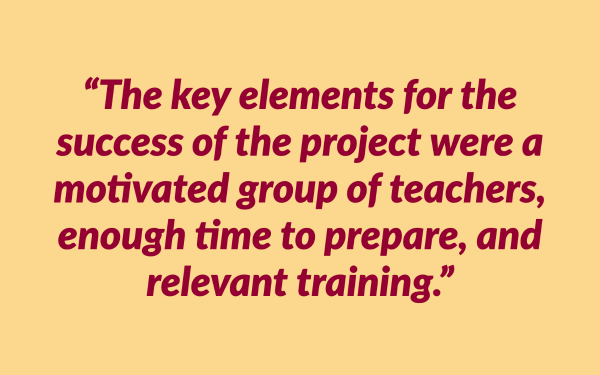
- A motivated group of teachers at the start of the project: actually, the desire to use iPads came from the teachers, as an anecdote told by Sofie clearly illustrates: “when one of the headmasters celebrated his birthday, some teachers put money together to buy him an iPad as a birthday present, so he would quickly be convinced of the advantages of this device”.
- Time: no steps were skipped in the process. It was important to respect the teachers that were doubtful when the school decided to launch the schoolwide 1:1 iPad project. The teachers got their iPad in April, which gave them the time to familiarize themselves with this new device and its use in the classroom from September.
- Training: in the months before the launch of the schoolwide 1:1 iPad project, the school organized a lot of training sessions for their teachers. This allowed the teachers to see examples of the possibilities and everybody started to see the possibilities for their courses.
The combination of these three elements allowed a smooth start of the project from the first day of the 2012-2013 school year.

However, no start comes without bumps in the road. Some of the parents were less enthusiastic about the project and went to court. It even turned into a political hot topic when the then-minister of education came close to canceling the entire project, only to be overruled by the regional minister-president who was in support of the idea of introducing innovation in the classroom. It’s hard to imagine this situation today in a post-COVID context, because the current Flemish minister of education is investing heavily in the purchase of digital devices for all secondary schools.
The advantages of iPads in the classroom
When asked why exactly they were so enthusiastic about iPads, Björn highlights three main reasons that still apply today:
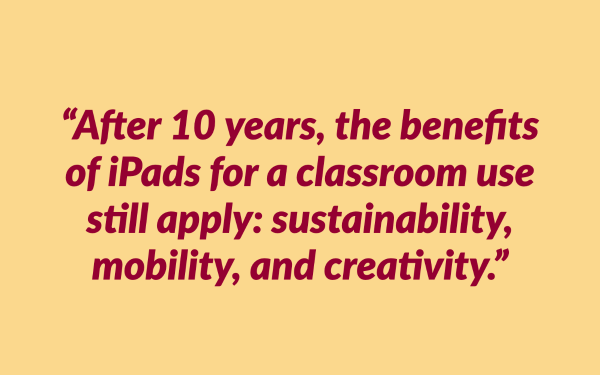
- Sustainability: back in 2011, not much was known about the iPads’ lifespan, but the school had the experience of Mac computers of which some were still working fine after 10 years. And their expectations were met, as Björn confirms: “Most of our iPads last at least six years, which means our students can do their full school career here with the same device”.
- Mobility: “An iPad is a very handy device. It’s easy to quickly grab it to look up some things or do an online exercise. Besides, the battery life is great. We just ask the students to have their iPad fully charged at the start of the day so we never need to charge them. Thanks to this, no infrastructural changes were needed in our school.”
- Creativity: “The built-in camera is a great thing. Furthermore, there was a large variety of apps available from the start and those gave a lot of possibilities for education. A lot of those apps also support creativity, the possibilities were —and are— endless.“
Björn understands the popularity of Chromebooks in other schools, which according to him is mainly because of the keyboard, which he personally is not missing on an iPad. “Students can perfectly do activities like BookWidgets on their iPad without a keyboard”.
A mix between the digital and the traditional ways of teaching
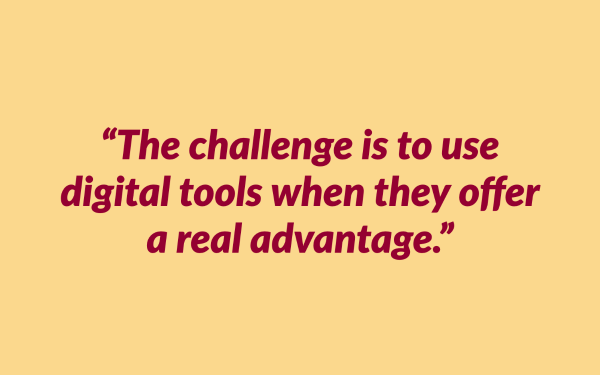
Being fully equipped with iPads doesn’t mean that all the lesson activities are exclusively done on this device. “We still use textbooks”, Sofie confirms. “Most textbooks offer a good structure for the students and it would be quite labor-intensive for teachers to develop all of their lesson material themselves when there are good textbooks available. Nowadays, most textbooks have a digital version or an online application that can be used on an iPad.”
Also Sofie: “For me, it’s a good thing to combine textbooks and digital learning on the iPad. I love the idea of mixing both and combining the best of both worlds. The challenge is to use digital tools when they offer a real advantage. Besides, it’s always a good idea to give teachers the time to adapt to the new possibilities. I’m quite sure a radical switch from the traditional way of teaching to a completely digital-only method would not work for most teachers and students.”
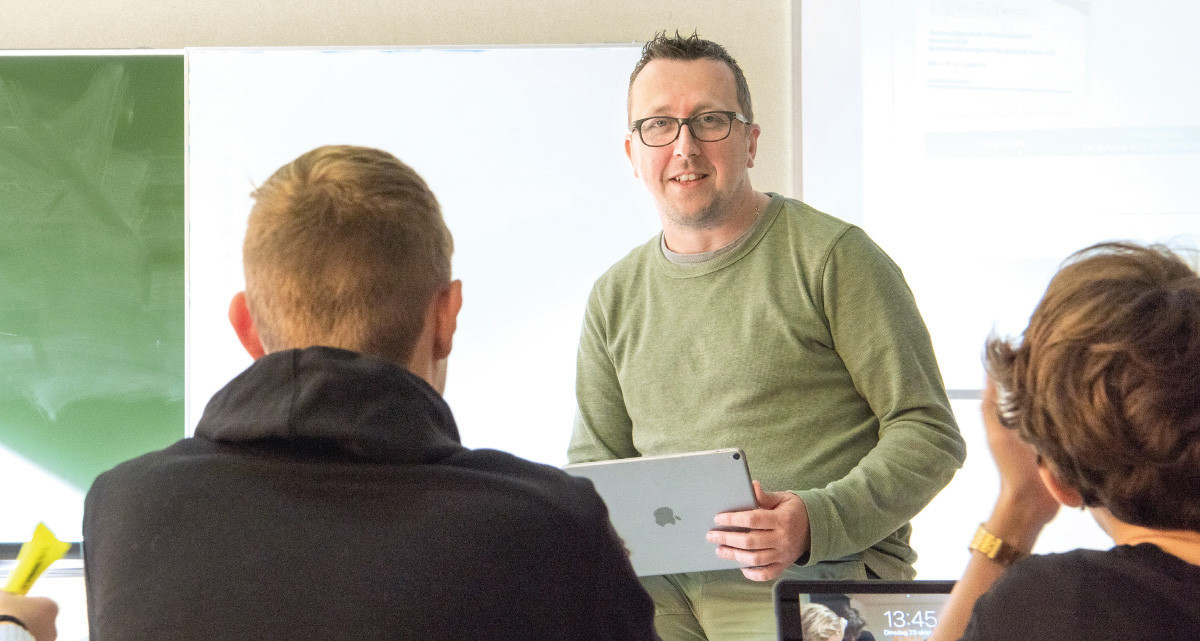
BookWidgets, the perfect app for teaching with iPads
When asked if there’s one app that almost all teachers in their school use, for Sofie and Björn it’s a no-brainer: “BookWidgets!”
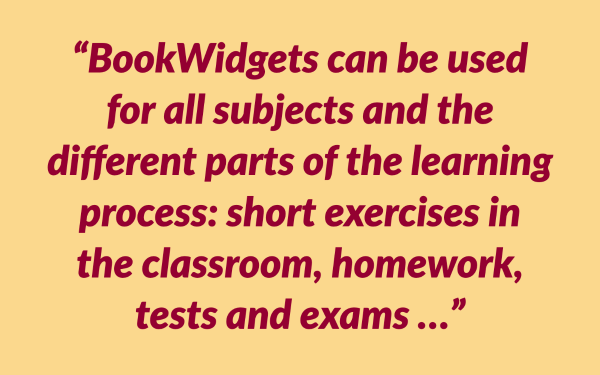
They both agree this app can be used for all subjects and the different parts of the learning process: short exercises in the classroom, homework, tests and exams …
Sofie is keen to explain how great the combination of iPads and BookWidgets can be: “every two years, with our history classes, we organize an excursion. The time of students walking around with clipboards and the typical experience of papers flying away whenever it was a bit windy is now a thing of the past. Now, I just prepare some activities on BookWidgets and I share them with my students. The last time we had this kind of excursion, it was about World War I, so I had all my students walk around in the trenches with their iPads, making pictures and responding to the questions. It was great to see.”

For Björn, other advantages are the possibilities of differentiation and the ease of sharing feedback with the students in a very efficient way.
Despite the differences in subjects they are teaching, Björn and Sofie use the same widget types: mainly the quiz and worksheet, because these widget types offer a large variety of question types. Björn, evidently, uses the question types related to maths too. They also use other widgets types like the Crossword puzzle, PairMatching, Memory game … so students can assimilate the lesson theories in a different way. Surprisingly, the one who uses the Timeline most is not history teacher Sofie, but math teacher Björn. He uses it to solve math problems in different steps.
Lockdown lessons
March 2020. On a Thursday evening, the Belgian National Security Council announces that schools will be closed starting from the next Monday. For many schools, remote learning turned out to be a challenge: too many students didn’t have access to decent devices, and most teachers were not prepared for online teaching. Were the teachers (and students) at Sint-Jozef Sint-Pieter school better prepared than their colleagues in other schools?
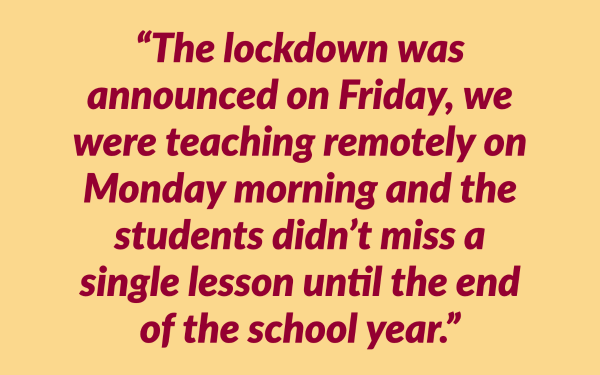
“Yes, without a doubt” Sofie and Björn both agree. “The lockdown was announced on Friday, we were teaching remotely on Monday morning and the students didn’t miss a single lesson until the end of the school year. Of course, there were some challenges. We had to adapt our teaching methods, and not seeing the students physically in the same room for such a long time wasn’t easy. But students and teachers were well equipped and they were already used to these devices and tools.” Sofie adds: “During this period of remote learning, BookWidgets was just great! It was a tough and lonely period, but at least the hard work pays off now because this year, I’ve been able to reuse a lot of the widgets created last year.”
Wrap up
What an inspiring story! We thank Björn and Sofie for sharing their experiences. If you’re teaching in Belgium and are inspired by the iPad project at Sint-Jozef Sint-Pieter school, don’t hesitate to get in touch with Lab 9, an official Apple and BookWidgets reseller.
Which digital devices and tools do you use in the classroom and how have your teaching methods changed since the start of the pandemic? Let us know on Twitter: @ibookwidgets!
